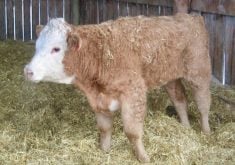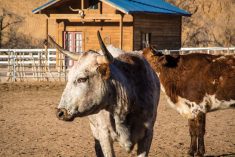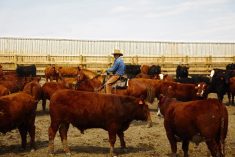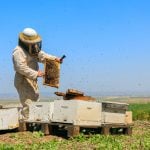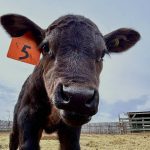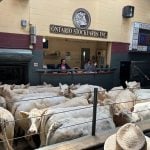Keep a closer eye on the chronic, less obvious cases of bovine respiratory disease, says one researcher. These infections often involve a biofilm in the respiratory tract, protecting the bacteria and making it more resistant to antibiotics.
Dr. Thomas Inzana, associate dean for research at Long Island University’s College of Veterinary Medicine, has been studying bovine respiratory disease (BRD) for 33 years. Most recently, his work has focused on biofilms in respiratory infections, which may account for the disease going undetected and treatment failure.
“We found that particularly in a chronic infection, which oftentimes bovine respiratory is, you’re dealing with a biofilm infection,” says Inzana. “To treat that infection, you really have to deal with the biofilm, not the organism.”
Read Also

Regenerative ranching sees Alberta family through three decades of ups and downs
Alberta ranchers have found regenerative ranching key to surviving ups and downs of the business
A biofilm can be described as a community of bacteria, adhering to a location such as the respiratory tract and then forming a polymeric substance of bacterial polysaccharide and other material, which encloses the bacteria. Inzana and his team discovered that bacteria within a biofilm are more resistant to both immune system defences and antimicrobials, making them more difficult to treat.
“The problem with the biofilm is a lot of times it may not be very obvious an infection is going on,” he says. “The symptoms may be relatively mild, but that’s the time you really have to catch it because following another infection or severe stress, you could suddenly find a dead animal.”
The presence of a biofilm is why some infections aren’t easily detected. “When they form biofilms, the disease is not as severe because they’re not producing a strong inflammatory response.”
According to the Beef Cattle Research Council’s website, BRD “refers to any disease of the upper or lower respiratory tracts,” and “is commonly associated with infections of the lungs causing pneumonia in calves that have recently been weaned or recently arrived at the feedlot.” The disease is caused by a range of viruses and bacteria, which can also cause several other systemic diseases in cattle. Environmental risk factors include stressful events, transportation, commingling and adverse weather. Symptoms of bacterial BRD may include coughing, difficulty breathing, fever of more than 40 C, depression, nasal discharge and reduced appetite.
The formation of the biofilm makes the bacteria within more resistant to antibiotics. “It’s partly because this matrix material shields them from the antibiotic, and it’s also partly because they’re not growing very effectively,” says Inzana. “They slow down their metabolism, and most antibiotics actually work on growing cells.”
An example of biofilm in a human context is some ear infections. “A lot of times the less severe infections are the ones that are not highly inflammatory and the child is not complaining that his ear really hurts, but he’s got a biofilm in the area and it’s really affecting his hearing,” he says. “In fact, he may have more severe long-term effects than the child who has a painful inflammatory response and is taken right to the doctor and treated.”
Similarly, BRD biofilm infections are harder to spot, but can be more damaging.
“If they have some signs of respiratory disease and it’s been going on for a week, they probably have a biofilm going on. And if they get a viral infection on top of that or they get overly stressed, that’s when they really come down with severe, acute disease,” says Inzana. “A lot of times… shipping fever occurs where tremendous stress just results in the animal dying relatively quickly. However, they may actually have had an infection in the respiratory tract for some time before that occurs.”
Finding a solution
Inzana and his team are now exploring what regulates biofilm formation and how to dissolve a biofilm.
“We’re using 3D tissue culture models right now to see how multiple bacteria within a biofilm interact and develop as they grow, and to try to identify novel compounds that will actually break up a biofilm,” he says. “A lot of people have identified compounds that inhibit biofilms. They usually do this by inhibiting growth. The problem is once you know the biofilm is there and organisms are more resistant to antibiotics, to treat it effectively you need to try to break up some of this matrix material to remove it.”
With recent funding from the United States Department of Agriculture National Institute of Food and Agriculture (USDA-NIFA), his team will search for compounds to break up biofilms.
“We have a colleague with a bank of 5,000 chemical compounds that we’ll be screening,” he says. He anticipates identifying the right compounds will take about three years. After identifying effective compounds, they’ll test them to ensure they’re safe for both cattle and humans and then test them in the 3D tissue culture system to see their potential effectiveness for treating these infections.
Effective treatment of a chronic biofilm infection is particularly important given their findings on BRD.
“We found particularly with Histophilus somni that it can go on for weeks and weeks. And another problem with a chronic respiratory disease, as opposed to one that’s very acute, usually systemic, is that it will really have a major effect on growth of the animal,” says Inzana.
Once effective compounds are identified, it will likely take several years before a product to treat biofilm infections is approved and available for use. This product would ideally dissolve the biofilm through an aerosol delivery to properly treat cattle with chronic respiratory infections.
In the meantime, Inzana encourages producers to be extra mindful of the less-severe symptoms of BRD that may indicate a chronic biofilm infection.
“I would try to have them look at their animals a little bit more closely to see if they have some symptoms of respiratory disease that aren’t necessarily really severe. They may have a chronic, mild infection going on in which a biofilm is present.”




